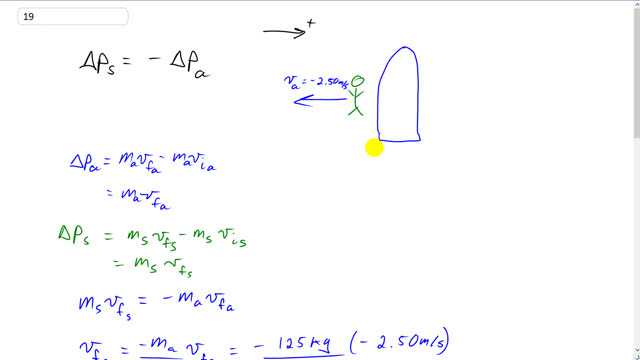
A 125-kg astronaut (including space suit) acquires a speed of 2.50 m/s by pushing off with her legs from a 1900-kg space capsule.
- What is the change in speed of the space capsule?
- If the push lasts 0.600 s, what is the average force exerted by each on the other? As the reference frame, use the position of the capsule before the push.
- What is the kinetic energy of each after the push?

In order to watch this solution you need to have a subscription.
This is Giancoli Answers with Mr. Dychko. Since this is a closed system that means the change in momentum of one part of it has to be equal and opposite to the change in momentum of any other part of it so that the total momentum of all parts in this closed system remains constant. And so we have the astronaut and the space capsule that makes our system and we are gonna take right to be the positive direction and so the change in momentum of the spaceship is equal and opposite to the change in momentum of the astronaut. So the impulse the astronaut experiences is mass times the final velocity of the astronaut minus the mass of the astronaut times his initial velocity; the initial is 0 so the change in momentum of the astronaut is equal to the astronaut's mass times his final velocity. And for the ship, it's the same idea so initial velocity of the ship is 0; this is true if you are taking the reference frame to be the initial position of the ship, I mean the ship is probably orbiting around Earth or something like that but we are just measuring our velocities with respect to the ship's position so initially, it's not moving at all with respect to itself so this is 0 here. And so we have the impulse of the ship is the ship's mass times its final velocity and well, we have ΔP a is m av f a so we put that in there and then we have ΔP s is m sv f s and so that's what we'll write here and with a negative there because that's what it says in that formula so I just substituted into this formula from each of these parts. And we can solve for the final velocity of the ship which is— it asks us for in part (a)—by dividing both sides by the mass of the ship and we have v f s is the ratio of masses times the final velocity of the astronaut. So that's negative 125 kilograms divided by 1900 kilograms times 2.50 meters per second which is 0.16 meters per second and that has two significant figures since the mass of the ship has two significant figures. For part (b), we need to know the force applied by one thing on the other. Now the sign on the force will depend what object you are talking about but the question is asking us, just in general, what is the magnitude of the force? That's its way of saying what's the force that one applies on the other so that's another way of saying what's the size of the force? So that's change of momentum divided by the time during which the force is applied and so we can take either mass velocity combination that we like so let's consider the astronaut. So we have 125 kilograms times negative 2.50 meters per second divided by 0.600 seconds which gives us 521 newtons is the size of the force that one object applies on the other. The kinetic energy for each thing will be its mass times its final velocity squared times a half so for the astronaut that's 125 kilograms times negative 2.50 meters per second squared divided by 2 and that gives 391 joules and then for the spaceship— same idea—we have one-half times its mass— 1900 kilograms— times 0.16447 meters per second squared and that gives us 26 joules and that has two significant figures because this number here has only two significant figures because it came out of this calculation here which had only two significant figures due to the mass of the ship having only two significant figures and there we go.
Why average force is based on ma*vfa and not ms*vfs?
Hi cm2hn, we could have used the space capsule final speed in part b), as you suggest, but that's taking a bit of a risk since we calculated the space capsule speed ourselves in part a), and we might have made an error in that calculation. Using the astronaut speed provided by the question is a safer approach, but outside of that, either speed is fine.
Why the speed of astronaut is negative? Would I get the same result if I use the capsule as the negative value?
The only thing that matters is that you're consistent with your coordinate system. This is to say that everything pointing in a particular direction needs the same sign (be it positive or negative doesn't matter, just that they're all the same), and things pointing in the opposite direction have the opposite sign. So, yes, you could make the capsule velocity negative, keeping in mind that this now means the force exerted on the capsule by the astronaut would also be negative in that coordinate system, since it would be directed to the right just the same as the now negative capsule velocity.